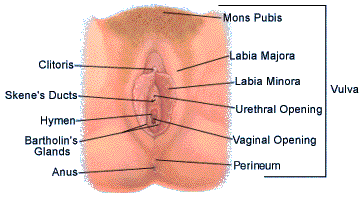

External Anatomy
Vulva
(VUL-vuh)
The vulva is a collective term used to describe the visible
external genital organs, extending from the mons pubis to
the perineum.
Mons pubis
(Mahns PEW-bis)
The mons pubis is the fatty tissue that covers the pubic bone.
After puberty, it is covered with thick hair that serves to
protect the genitals from moisture.
Labia
majora (LAY-be-uh MUH-jo-ruh)
Labia majora means "large lips" in Latin. The labia
majora are the large, outer lips of the vulva that extend from
the mons pubis down either side of the vulva. They are covered by
pubic hair and contain fatty tissue under the skin.
Labia
minora (LAY-be-uh My-NOR-uh)
The labia minora are the smaller, fleshy inner lips of the vulva
that are inside the labia majora and closer to the vaginal
opening. They are not covered by pubic hair. The size of the
labia minora will change as girls develop through puberty and as
women go through menopause.
Clitoris
(CLIT-or-is)
The clitoris is a small, firm, rounded organ at the top of the
vulva, just above the urethra, that measures about 1/4 of an
inch. The clitoris is an important organ for female sexual
responsiveness. It is composed of erectile tissue and blood
vessels. The clitoris is derived from the same developing tissue
that eventually becomes a penis in a little boy.
Skene's
glands
The skene's glands cannot be seen because they are under skin.
These glands empty through tiny openings that are on either side
of the urethra. The purpose of these two glands is unknown;
scientists believe that they might once have secreted lubricants
to protect the urinary opening and the urethra from bacteria.
Bartholin's
glands (BAR-tho-linz glans)
Bartholin's glands cannot be seen or felt because they are under
skin on either side of the vaginal opening (introitus). These two
glands help lubricate the vagina and vulva by secreting a thin
mucus from two ducts.
Urethra
(You-REE-thruh)
The urethra is a short tube connected to the bladder that
transports urine to the urethral opening. This opening can be
seen as a very small, v-shaped dimple below the clitoris.
Like the vagina, the urethra may also become thinner with less
strength to remain in a closed position during the years leading
up to and beyond menopause. Caused by the reduction in estrogen,
this loss of elasticity may result in a sense of urgency to
urinate, and loss of bladder control. Kegel exercises can be
invaluable in strengthening the pelvic muscles which can help
maintain good bladder control.
Hymen
(HI-min)
The hymen is a thin, delicate mucous membrane surrounding the
vaginal opening. Normally, it has a perforation or opening in the
center. Rarely, a girl is born with a hymen that is not open
which prevents the flow of menstrual fluids as well as
intercourse. If the hymen is closed, it requires surgical
correction. If the hymen has been torn or stretched, it may bleed
and small flaps of skin may remain called hymenal tags.
Vaginal
Opening
The vaginal opening, or the introitus, is the entrance to the
reproductive system, and through which flow menstrual blood and
vaginal discharge.
Perineum
(Pair-in-EE-um)
The perineum is the area between the vagina and the anus.
Anus
(A-nus)
The anus is the outer opening to the rectum and bowels. After
puberty, pubic hair may grow around the anus, and the skin may
darken in color.
[Homepage] [Internal Anatomy] [Menstrual Problems] [Introduction] [Breast Self-Exam]
The contents of this Web site are for informational purposes only and are not intended to be used for medical advice. You should consult your physician or health care provider on a regular basis. You should consult your physician immediately with any problem about which you are concerned.